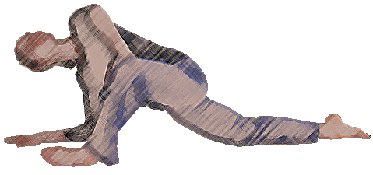 When we have arrived at our edge, once we have become still, all that is left to do is to stay. The yin tissues we are exercising are not elastic tissues. They do not respond well to constant movement: they are plastic. Plastic tissues require long-held, reasonable amounts of traction to be stimulated properly.
When we have arrived at our edge, once we have become still, all that is left to do is to stay. The yin tissues we are exercising are not elastic tissues. They do not respond well to constant movement: they are plastic. Plastic tissues require long-held, reasonable amounts of traction to be stimulated properly.
Reasonable is a relative word. If you have ever worn braces you know that the pressure is not comfortable, but neither is it the maximum you could bear. Your orthodontist knows that applying twice as much tension in the braces does not mean you can get away with wearing them for only half as long. Yin tissues don’t respond to maximum stresses for a short time.
Paul Grilley noticed that basketball players, who jump up and down, placing tremendous loads upon the ligaments of their feet, do not develop fallen arches. Their arches don’t fall because the extreme strain is very brief. They are more likely to break bones, or tear ligaments or tendons in their feet, than to develop fallen arches. However, a one-hundred-pound waitress, who is standing on her feet for eight hours a day, is a prime candidate for fallen arches. She is experiencing a gentle pressure for a long period of time. That is the condition for changing our yin tissues.
Yang postures may be held for as little as five breaths, or as long as a couple of minutes, depending upon the style of yoga being practiced. All yang poses require muscular engagement to maintain the pose. Yang tissues require yang exercise. Yin postures are generally held for at least one minute, and for some people as long as twenty minutes. Yin tissues require yin exercise. It is the long, gentle pressure that coaxes yin tissues into being strengthened.
It can be dangerous to mix up these forms of exercise. Yang tissues can be damaged by being stressed in a yin manner – statically held in one position for a long period of time. No physical trainer would suggest you try to build stronger biceps by holding a heavy barbell in a half-curled position for five minutes. Muscles need repetitive movement to grow stronger. Similarly, being stressed in a yang manner can damage yin tissues. Repetitively dropping back from standing into the wheel pose can overwork the ligaments in the lower back, eventually wearing them out. We must make sure we exercise yang tissues in a yang way and yin tissues in a yin way. The yin way is to hold a pose under a reasonable, non-maximum stress for long periods of time.
If you are practicing on your own, use a timer or a stopwatch to set a constant length of time for the postures – three to five minutes may work well for you. If you are just beginning Yin Yoga, you may want to start with one- or two-minute holds and work your way toward longer periods. You may find that some postures allow you to remain in the pose longer than others – this is all right. Our bodies are not uniformly open. It may be better to stay in a challenging pose, like saddle, for less time than in an easier pose, like butterfly. If you are struggling to remain in a pose, come out – regardless of whether the timer has sounded or not.
The yin practice is very portable – you can take it with you anywhere – you don’t need a yoga studio, you don’t even need a yoga mat. All you need is four cubits of space on the floor. That is to say – all you need is enough room to stretch out. You can do these poses while doing other activities. While this may not provide you with the deepest benefits – the meditation practice you get with a dedicated practice – you can still affect your tissues physically. Sitting in yin poses while reading or talking on the phone, while eating at your coffee table or watching television, will help open the tightest hips. [1]
One last bit of advice: people love to do things that they love to do. Sounds obvious. Said another way, when you are in balance you will tend to keep doing things that keep you in balance. However, when you are out of balance, you will tend to continue to do things that keep you out of balance! Active people love to do active yoga. Calmer people (a nice way of saying less active people) love to do calming yoga. Don’t always practice what you love; practice what you need! Active people probably need Yin Yoga more than anyone else. Calm people probably need to do more yang practices more than anyone else.
Now that you have some idea of how to practice Yin Yoga, the next step is to learn the postures, also known as the asanas.
(Next: Practicing Asanas )
